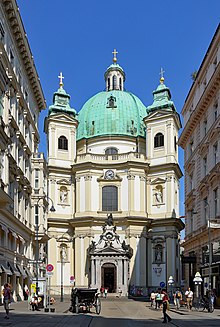St. Peter's Church, Vienna
| Peterskirche | |
|---|---|

Peterskirche, from the Graben
|
|
| Basic information | |
| Location | Vienna, Austria |
| Geographic coordinates | 48°12′33″N 16°22′10″E / 48.2093°N 16.3695°ECoordinates: 48°12′33″N 16°22′10″E / 48.2093°N 16.3695°E |
| Affiliation | Catholic Church |
| Province | Archdiocese of Wien |
| Year consecrated | 1733 |
| Leadership | P. Christian Spalek S.C.O.D. |
| Website | www |
| Architectural description | |
| Architect(s) | Gabriele Montani (initial plan) Johann Lukas von Hildebrandt (modifications) Kilian Ignaz Dientzenhofer (facade) |
| Architectural type | Church |
| Architectural style | Baroque |
| Groundbreaking | 1701 |
| Completed | 1733 |
| Specifications | |
| Direction of façade | SW |
| Capacity | 400 |
| Length | 50 metres (160 ft) |
| Width | 20 metres (66 ft) |
| Height (max) | 56.8 metres (186 ft) |
| Dome(s) | 1 |
| Dome height (outer) | 54 metres (177 ft) |
| Dome dia. (outer) | 30 metres (98 ft) |
Peterskirche (English: St. Peter's Church) is a Baroque Roman Catholic parish church in Vienna, Austria. It was transferred in 1970 by the Archbishop of Vienna Franz Cardinal König to the priests of the Opus Dei.
The oldest church building (of which nothing remains today) dates back to the Early Middle Ages, and there is speculation that it could be the oldest church in Vienna (See Ruprechtskirche). That Roman church was built on the site of a Roman encampment.
This church was replaced with a Romanesque church with a nave and two aisles. It is believed to have been established by Charlemagne around 800, although there is no evidence supporting this view. At the outside of the church, there is a relief sculpture by R. Weyr consecrated to the founding of the church by Charlemagne. In any case, a church of Saint Peter in Vienna is first mentioned in 1137. Around the end of the 12th century, the church became part of the Schottenstift.
The mediaeval church had three altars, with an apse in the south instead of the normal eastern orientation. This unusual feature has triggered many discussions among experts, and it is suspected that the church was adapted from a previously secular building. The church was surrounded by shops and a nearby building housed the Stadtguardia, a forerunner of the modern police. The old church burned down in 1661 and was given only makeshift repairs. The decision to build a new church was taken up with the arrival of the Fraternity of the Holy Trinity of which the emperor Leopold I was a member. He had taken a vow to rebuild this church when Vienna was ravaged by the plague in 1679-1680.
...
Wikipedia
